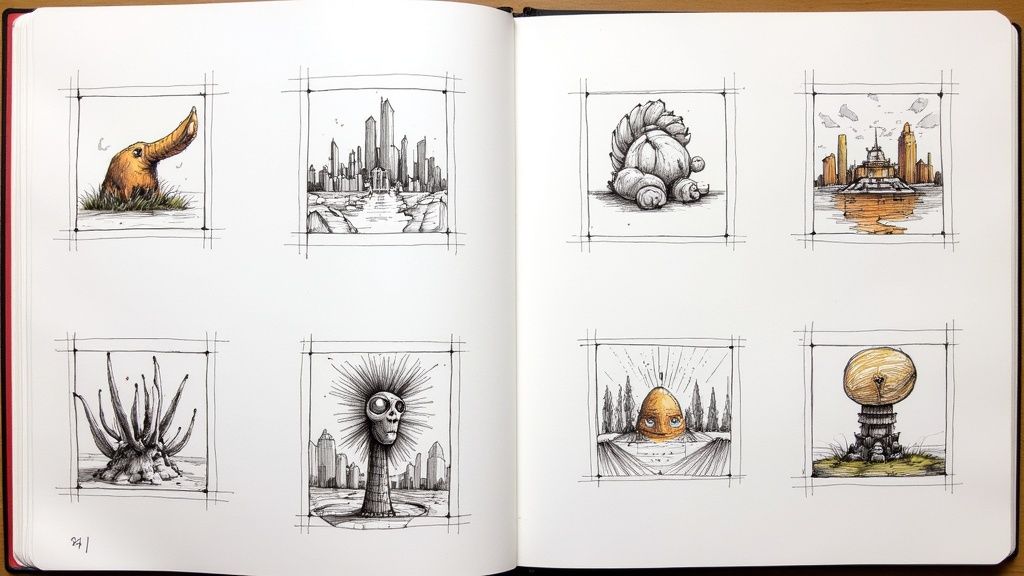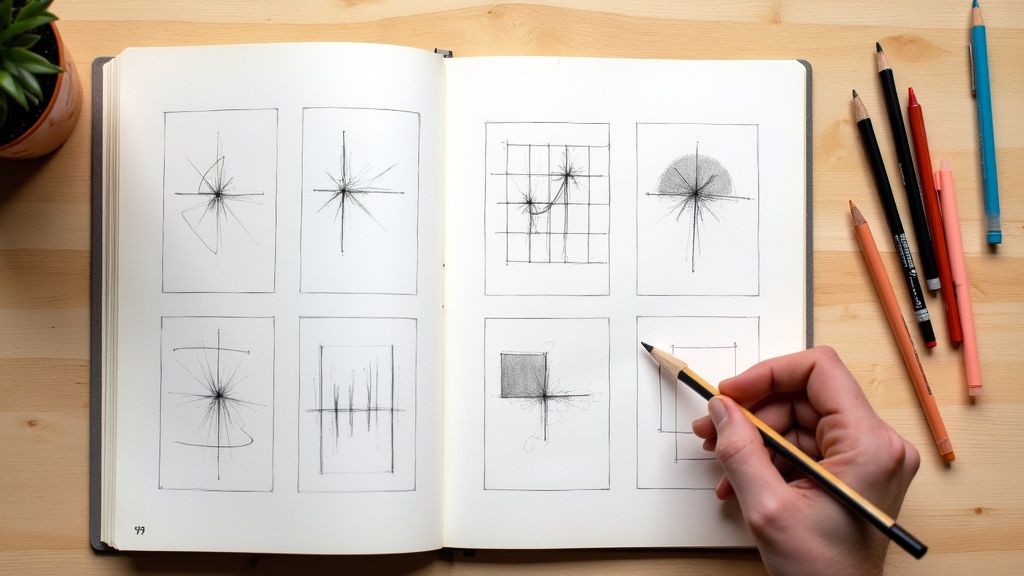Welcome, artists and doodlers! Staring at a blank page, searching for a spark of inspiration? You have come to the right place. Overcoming artist's block often means finding fresh, engaging prompts that reignite your passion, and this guide provides a curated collection of cute drawing ideas designed to do just that. We will explore diverse themes, from globally beloved kawaii animal characters to charming anthropomorphic foods and whimsical tiny cottages.
Each idea is more than a simple suggestion. It is a launchpad for your creativity, complete with specific features, practical tips, and actionable examples to get your pen moving immediately. Whether you are a beginner learning the basics of proportion or a seasoned illustrator seeking a new theme for your portfolio, these concepts are perfect for building your skills. They are also great for populating a social media feed or simply enjoying the therapeutic act of creating something undeniably adorable.
This list offers a structured approach to cuteness, breaking down why certain elements work and how you can apply them. Get ready to transform that empty canvas into a world of charm and imagination, starting with the first prompt.
1. Kawaii Animal Characters
Originating from Japan, the Kawaii style is the art of "cuteness," and it provides a fantastic framework for adorable animal drawings. This aesthetic focuses on exaggerating features to create an overwhelmingly charming and innocent appeal. The core principle involves simplifying forms into soft, rounded shapes and distorting proportions, particularly with oversized heads and large, expressive eyes. This makes it one of the most accessible and rewarding cute drawing ideas for artists at any skill level.
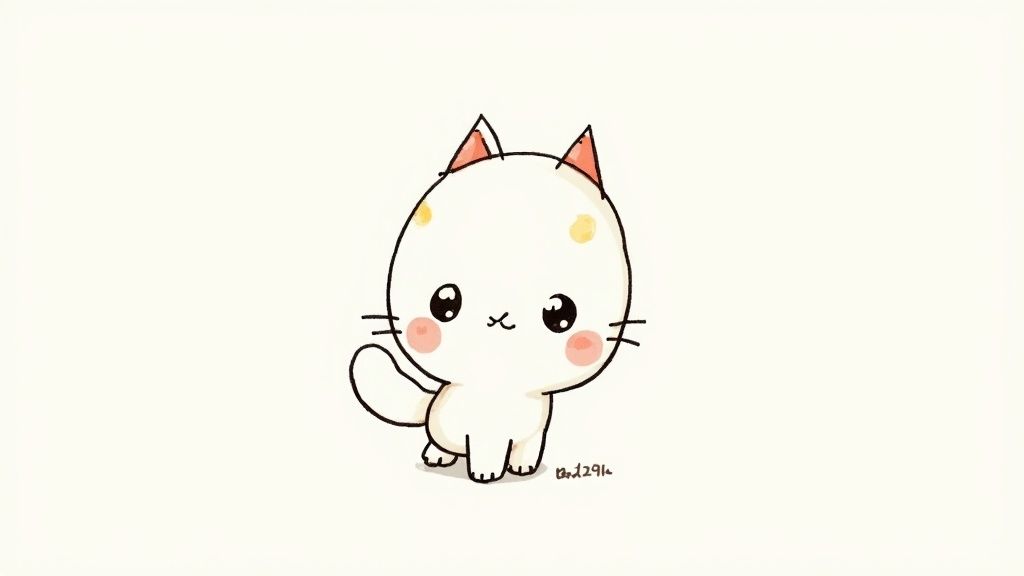
The charm of Kawaii characters, like Sanrio’s Hello Kitty or Claire Belton’s Pusheen, lies in their simplicity. They evoke a strong emotional response with minimal detail, making them instantly lovable. This style is perfect when you want to create characters that are universally appealing and emotionally resonant.
How to Draw in a Kawaii Style
To successfully create your own Kawaii animal, focus on a few key proportional rules that define the style. These guidelines help ensure your creation has that signature 'cute' factor.
- Start with Simple Shapes: Use circles and ovals as the foundation for the head and body. A large circle for the head and a smaller, squatter oval for the body is a classic combination.
- Emphasize the Eyes: Make the eyes a dominant feature. A good rule of thumb is to make them at least one-third the width of the head. Keep them simple, often just black circles with one or two white dots for a reflective glint.
- Simplify Facial Features: Place the nose and mouth low on the face, typically in the bottom third, to create a larger forehead and a more childlike look. A tiny "w" for a mouth or a simple dot for a nose works perfectly.
- Add a Touch of Blush: Small ovals or simple hash marks on the cheeks under the eyes instantly add warmth and extra cuteness.
- Keep Lines Soft: Use a consistent and soft line weight. Avoid sharp, jagged edges in favor of smooth, rounded curves to maintain a gentle appearance.
2. Food with Faces (Anthropomorphic Food)
Giving everyday food items a touch of personality is one of the most delightful and creative cute drawing ideas. This charming style, known as anthropomorphism, involves adding simple faces, arms, and legs to fruits, desserts, and drinks. The concept transforms ordinary food into lovable characters that express human-like emotions, turning a simple apple or a cup of coffee into a joyful, grumpy, or shy personality. This approach is highly flexible and offers endless creative possibilities.
)
The appeal of food with faces, seen in Kidrobot’s Yummy World plush toys and modern emoji designs, comes from the element of surprise and whimsy. It’s an accessible style that doesn’t require complex anatomy skills but allows for significant character development. Use this approach when you want to create illustrations that are immediately relatable, humorous, and full of life. For more inspiration, you can learn more about drawing Kawaii food friends.
How to Draw Anthropomorphic Food
To bring your food characters to life effectively, focus on expression and placement. A few simple rules can help make your tasty creations more believable and engaging.
- Study Real Food: Before you start, observe the food's natural shape, texture, and color. This will help you place features in a way that feels natural, like putting a face on the smooth side of an avocado half.
- Keep Features Simple and Proportional: Much like the Kawaii style, simple dot eyes and a small curved mouth are often all you need. Keep the facial features relatively small compared to the food item to emphasize its form.
- Place the Face Strategically: Position the face on the most recognizable or prominent surface of the food. For a slice of cake, this would be the front-facing side; for a strawberry, it would be the broad area below the stem.
- Express Personality Through Details: Use eyebrows and mouth shapes to convey emotion. A pair of arched eyebrows can show surprise, while a simple upturned curve for a mouth creates an instant smile.
- Use Complementary Colors: When adding accessories like bows or hats, choose colors that complement the food’s natural palette to create a harmonious and visually appealing character.
3. Chibi Characters
Chibi is a Japanese slang word for "short" and refers to an art style that depicts characters with dramatically exaggerated, childlike proportions. This style intentionally shortens characters to be about two to four heads tall, contrasting sharply with the more realistic seven to eight heads. The primary goal is to maximize cuteness by focusing on oversized heads, large expressive eyes, and tiny bodies, making it a powerful tool for creating adorable art.
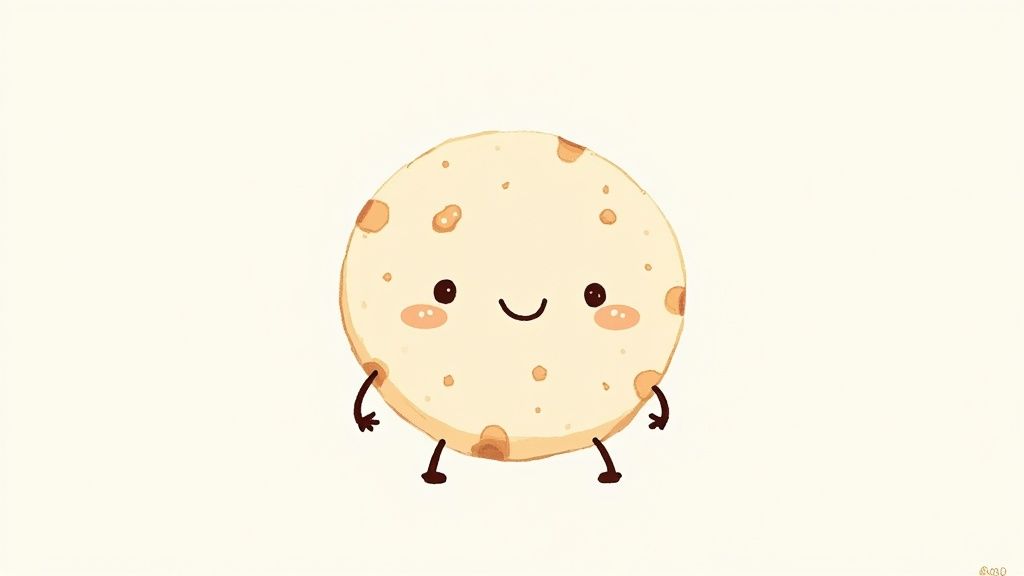
The charm of Chibi characters, seen in the popular Nendoroid figures from Good Smile Company or character designs in the Hetalia series, lies in their condensed and expressive nature. This style is perfect for comedic effect, fan art, or when you want to create an endearing version of a complex character. It's one of the most beloved cute drawing ideas because it distills a character's essence into a simple, charming form.
How to Draw in a Chibi Style
To capture the iconic Chibi look, you need to master its unique proportions and simplify details while preserving the character's identity. These guidelines will help you create authentically cute Chibi art.
- Master Basic Proportions: The head is the largest part of the body. A common rule is the "1:1" ratio, where the body's height is roughly equal to the head's height. This creates the classic short, stout appearance.
- Emphasize the Eyes and Eyebrows: The eyes are the window to a Chibi's soul and should be large, detailed, and expressive. Use the eyebrows to amplify emotions, whether it's surprise, anger, or joy.
- Simplify Clothing Details: Capture the most recognizable elements of an outfit but remove intricate patterns or folds. The key is to maintain the character's signature look without cluttering the small frame.
- Use Soft, Rounded Shapes: Avoid sharp angles and straight lines. Use smooth, curved lines for the body, limbs, and even hair to enhance the soft and huggable feel of the character.
- Practice Various Emotional Expressions: Because Chibis are so expressive, practice drawing a range of emotions. Exaggerate facial features, like a wide-open mouth for a scream or giant teardrops for sadness, to make your drawings more dynamic.
4. Cute Plants in Pots
Merging the joy of botany with whimsical artistry, cute plants in pots offer a charming drawing idea that taps into the popular houseplant trend. This concept involves illustrating succulents, flowers, and leafy foliage in decorative containers, often giving them anthropomorphic qualities like sweet faces or playful accessories. The core idea is to transform ordinary houseplants into endearing characters, celebrating the connection between people and their botanical companions. This makes for an incredibly versatile and heartwarming category of cute drawing ideas.
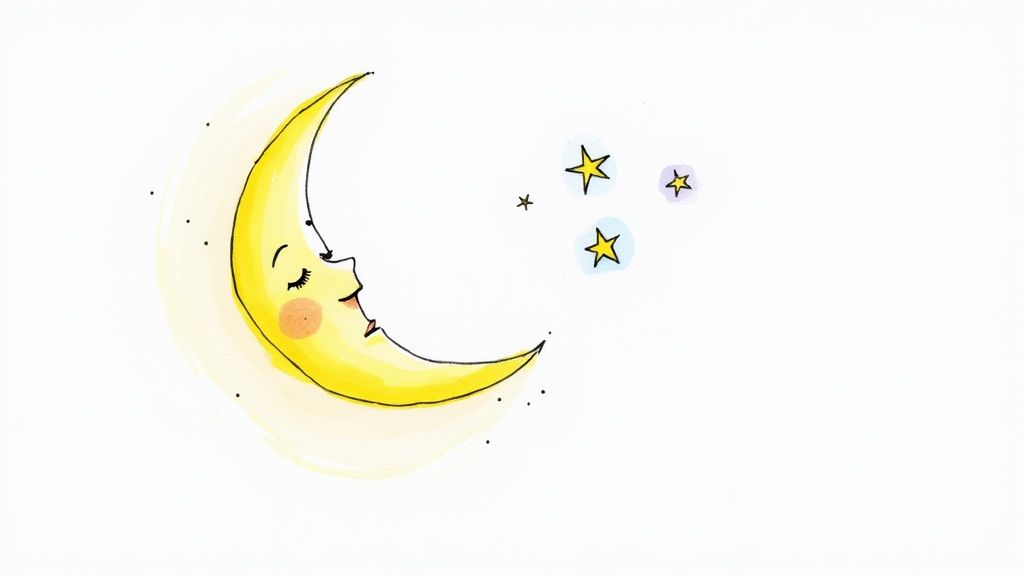
The appeal of this style is evident in the work of botanical illustrators and across social media, where the "plant parent" community thrives. These drawings can personify the personality of a specific plant, like a sleepy succulent or a cheerful sunflower. This approach is perfect for creating relatable content, from planner stickers and journal designs to branding for a cozy nursery or cafe.
How to Draw Cute Potted Plants
Creating your own adorable botanical illustrations involves combining accurate plant observation with a touch of imagination. These guidelines will help you cultivate charming plant drawings.
- Start with the Pot: The container sets the stage for your plant's personality. Experiment with different pot shapes like cylinders, cubes, or novelty shapes like animals. Add patterns, textures, or even little faces to the pot itself.
- Study Real Plant Structures: Observe how different plants grow. Look at the leaf shapes of a monstera, the layered petals of a rose, or the chubby leaves of a succulent. Simplifying these real-life structures is key to a recognizable and cute design.
- Add a Face or Personality: The easiest way to add charm is by giving the plant a simple face. Use two dots for eyes and a small curve for a mouth on a prominent leaf or the pot. You can also give them tiny arms or accessories like glasses or a small hat.
- Create a Themed Collection: Draw a series of plants with a consistent style. For example, a "sleepy succulent" collection in pastel-colored pots or a "kitchen herb garden" with cheerful, energetic expressions.
- Incorporate Environmental Details: Enhance your drawing by adding context. Include a tiny watering can, a gardening trowel, a sunbeam, or a few water droplets to tell a small story and make the scene more dynamic.
5. Baby Animals
Drawing baby animals taps into the innate appeal of youth, focusing on the naturally cute characteristics that young creatures possess. This approach emphasizes features like oversized eyes, fluffy fur, slightly clumsy proportions, and innocent expressions to capture the universal charm of juvenile animals. Unlike stylized art forms like Kawaii, this idea leans into a more realistic, albeit exaggerated, depiction of nature, making it a wonderful source for cute drawing ideas that feel both heartwarming and authentic.
The charm of baby animals, seen in Disney films or National Geographic photography, comes from their vulnerability and burgeoning life. They evoke powerful feelings of nurturance and affection with their undeveloped features and playful antics. This style is perfect when you aim to create emotionally resonant artwork that connects with the viewer on a deeply instinctual level.
How to Draw Cute Baby Animals
To successfully capture the essence of a baby animal, it's important to study and emphasize the key features that define their youthfulness. These guidelines will help you create a drawing that is undeniably adorable and true to its species.
- Study Real Proportions: Look at photos of real baby animals. Notice how their heads are often disproportionately large for their bodies, and their limbs can be short and stubby. Replicating this is key.
- Emphasize Large, Curious Eyes: Like in Kawaii, large eyes are crucial, but here they should look more realistic. Make them wide, round, and full of curiosity or innocence. A soft, glossy reflection adds life.
- Focus on Soft Textures: Use soft shading, stippling, or fine lines to create the impression of downy feathers or fluffy baby fur. Avoid harsh, sharp lines to maintain a gentle and delicate feel.
- Capture Youthful Posture: Baby animals are often clumsy. Draw them in playful or slightly awkward poses, like tumbling, taking a wobbly step, or curiously peering out from a nest or from behind a parent.
- Keep Details Species-Specific: Pay attention to the unique traits of the animal you’re drawing. A baby elephant's floppy ears and trunk, a duckling's fuzzy down, or a fawn's spots will make your drawing more believable and endearing.
6. Tiny Houses and Cottages
Drawing tiny houses and whimsical cottages offers a delightful way to explore architectural charm on a miniature scale. This style transforms ordinary structures into enchanting abodes by exaggerating cozy features and incorporating fantastical elements. The core idea is to create a sense of warmth, safety, and fairy-tale wonder through thoughtful design, making it one of the most heartwarming cute drawing ideas available.
The appeal of these drawings, much like the Hobbiton homes from The Lord of the Rings or the quaint structures in Thomas Kinkade's paintings, is in their inviting and story-filled nature. They suggest a peaceful, simple life and invite the viewer to imagine the inhabitants. This style is perfect for creating illustrations that feel both nostalgic and magical, evoking a sense of cozy escapism.
How to Draw a Cute Tiny Cottage
To capture the essence of a charming miniature home, focus on architectural details and environmental storytelling that amplify its quaintness. These guidelines will help you build a cozy and captivating scene.
- Start with Simple Shapes: Begin with basic geometric forms like squares, rectangles, and triangles for the main structure. Don't worry about perfect lines; slightly skewed or rounded shapes add character.
- Add Personality with Details: The magic is in the unique features. Incorporate rounded doors, small paned windows with flower boxes, a crooked stone chimney, or climbing ivy. These elements transform a simple house into a personality-filled home.
- Use Perspective for Depth: Even a simple one-point perspective can make your cottage feel more three-dimensional and inviting. Place it within a landscape to create a complete scene.
- Include Natural Surroundings: Frame your cottage with a winding path, oversized mushrooms, a picket fence, or blooming flowers. These landscape elements enhance the cozy, secluded feeling. For more inspiration, you can learn more about drawing a charming cottage on DrawingList.com.
- Focus on Texture: Use line work to suggest different materials like rough wood grain for the door, bumpy stone for the walls, and soft shingles for the roof. Texture adds visual interest and realism to your cute creation.
7. Cute Monsters and Creatures
Transforming traditionally scary monsters into friendly, approachable characters is a fantastic way to generate unique and cute drawing ideas. This concept involves taking the core elements of mythical beasts, horror icons, or imaginary creatures and reinterpreting them through the lens of cuteness. By softening their features and giving them innocent expressions, you create an appealing juxtaposition that is both charming and imaginative. This art style keeps recognizable monster traits but makes them feel more like lovable companions than fearsome foes.
The success of this style is evident in popular culture, from the expressive characters in Pixar's Monsters, Inc. to the iconic designs of Pokémon. These creations maintain a hint of their monstrous origins while being overwhelmingly adorable. This approach is perfect for developing memorable characters that stand out, blending the familiar with the unexpected to capture an audience's imagination.
How to Draw Cute Monsters and Creatures
To design your own lovable monster, balance its classic creature features with cute design principles. This ensures your creation is recognizable as a monster but is still undeniably sweet.
- Start with Monster Mythology: Research traditional monsters like dragons, vampires, or yetis. Identify their key characteristics, such as horns, fangs, or fluffy fur, and incorporate simplified, softened versions into your drawing.
- Use Friendly Colors: Apply color psychology to your advantage. Use bright, cheerful palettes with soft pastels or vibrant primary colors instead of dark, menacing shades. This immediately signals a friendly and non-threatening personality.
- Embrace Soft Shapes: As with other cute styles, rely on rounded shapes and avoid sharp, aggressive angles. A fluffy cyclops or a pudgy kraken with smooth, noodle-like tentacles feels much more approachable.
- Give Them Kind Eyes: The eyes are critical for conveying emotion. Design large, expressive eyes with a curious or happy glint. Even a creature with multiple eyes can look cute if they appear friendly and inquisitive.
- Create a Backstory: Develop a simple personality or backstory for your monster. Is it a shy ghost who is afraid of the dark, or a goofy zombie who loves to garden? A compelling personality adds depth and makes your character more endearing.
8. Cute Celestial Objects
Transforming the vastness of space into something friendly and approachable is a delightful challenge, and personifying celestial bodies is one of the most charming cute drawing ideas. This concept involves giving personalities to stars, planets, and moons by adding expressive faces and simple features. It blends the wonder of astronomy with whimsical character design, creating everything from sleepy crescent moons to cheerful, smiling suns.
The appeal of cute celestial objects lies in their ability to make the cosmic feel personal and cozy. This style is often seen in children's educational materials, space-themed nursery decor, and merchandise, where characters like a winking star or a blushing Saturn capture the imagination. It’s a perfect way to spark curiosity about space while creating universally heartwarming art.
How to Draw Cute Celestial Objects
To give your astronomical art a dose of adorable personality, focus on simple character design principles while honoring the object's real-life characteristics. These guidelines will help you create a universe of charming figures.
- Start with the Object’s Core Shape: Use the natural form of the celestial body as your base. A circle works for a planet or sun, a crescent for the moon, and a classic five-pointed shape for a star.
- Give it a Simple, Sweet Face: Apply the Kawaii principle of placing features low on the "face" to create a childlike appearance. Two simple dots for eyes and a small, curved line for a smiling mouth are often all you need.
- Incorporate Authentic Details: Add a unique touch based on the real object. Give Saturn its rings, add craters to the Moon, or draw sunspots on the Sun. This detail adds character and a subtle educational element.
- Use a Thematic Color Palette: Stick to colors associated with your subject. Use warm yellows and oranges for the Sun, cool blues and whites for the Moon, and research the actual colors of planets like Mars (reddish-orange) or Neptune (deep blue).
- Add Cosmic Friends: Create a dynamic scene by drawing interactions. Show a small star orbiting a friendly planet or a group of stars twinkling together. Adding elements like shooting stars or soft clouds can enhance the dreamy atmosphere. For more intricate space-themed patterns, explore ideas for a celestial mandala.
9. Cute Transportation Vehicles
This art style transforms ordinary cars, trains, airplanes, and boats into charming characters by giving them faces and distinct personalities. The approach involves anthropomorphizing machines, turning functional objects into relatable figures with expressive features. This is one of the most imaginative cute drawing ideas, allowing you to blend mechanical design with character art, creating a world where vehicles are friendly and full of life.
The widespread appeal of this style is evident in iconic series like Disney Pixar’s Cars and Thomas the Tank Engine. These characters prove that even non-living objects can evoke strong emotions and tell compelling stories. This concept is perfect for creating playful illustrations for children’s books, animations, or simply exploring creative character design.
How to Draw Cute Transportation Vehicles
Drawing cute vehicles involves a clever blend of their real-world structures with classic character design principles. The goal is to make the machine look alive without losing its identity as a vehicle.
- Study Real Vehicle Proportions: Start by lightly sketching the basic shape of the vehicle you want to draw. Understanding its fundamental components, like the chassis, wheels, and cabin, will help you place anthropomorphic features convincingly.
- Use Headlights and Grilles for Faces: The front of a vehicle is a natural canvas for a face. Use the headlights as eyes and the grille or bumper as a mouth. You can create a wide range of expressions, from a happy grin with a curved grille to a determined look with angled headlights.
- Maintain Functional Characteristics: Keep the core purpose of the vehicle visible. An airplane should still have wings and a boat should look seaworthy. This grounding in reality makes the cute elements more delightful and effective.
- Add Personality with Color and Accessories: Use bright, cheerful color palettes to enhance the friendly vibe. Adding accessories like a hat on the roof, eyelashes on the headlights, or stickers on the side can further define your vehicle’s character.
- Include Appropriate Settings: Place your cute vehicle in a setting that tells a story. A cheerful little car driving down a sunny, winding road or a happy steamboat chugging along a river adds context and charm to your drawing.
Cute Drawing Ideas Comparison Table
Style | Implementation Complexity | Resource Requirements | Expected Outcomes | Ideal Use Cases | Key Advantages |
|---|---|---|---|---|---|
Kawaii Animal Characters | Beginner to Intermediate | Basic drawing tools, soft colors | Simple, universally appealing cuteness | Social media, beginner art, any animal | Easy to learn, therapeutic, highly shareable |
Food with Faces | Beginner to Intermediate | Digital or traditional media | Cute anthropomorphic food characters | Children's books, restaurant marketing | Encourages healthy habits, endless variety |
Chibi Characters | Intermediate | Moderate art skills, stylization | Expressive, childlike character art | Anime/manga fandom, merchandise, stickers | Fast to draw, highly expressive |
Cute Plants in Pots | Intermediate | Botanical knowledge, detailed tools | Whimsical plant-art blend | Plant communities, social media, decor | Combines creativity with nature, trendy |
Baby Animals | Intermediate to Advanced | Animal anatomy study, shading tools | Heartwarming, realistic juvenile animals | Wildlife media, greeting cards, education | Emotionally engaging, anatomically informative |
Tiny Houses and Cottages | Intermediate to Advanced | Architectural understanding, fine detail | Whimsical cozy structures | Home décor, fantasy art, tiny house advocates | Endless variations, creative fantasy |
Cute Monsters and Creatures | Intermediate | Character design, mythology research | Friendly monster characters | Gaming, animation, children’s media | Helps reduce fear, creative freedom |
Cute Celestial Objects | Beginner to Intermediate | Astronomy knowledge, color media | Educational, charming space-themed art | Nursery decor, educational materials | Combines science and art, universal appeal |
Cute Transportation Vehicles | Intermediate | Vehicle design knowledge, stylization | Friendly vehicle characters | Children’s media, automotive marketing | Appeals to kids and enthusiasts, educational |
Turn Your Inspiration Into Action
We've explored a whimsical world packed with cute drawing ideas, from the charmingly simplified forms of kawaii animals to the expressive, big-headed appeal of chibi characters. This journey has taken us through anthropomorphic foods that smile back, tiny cottages that radiate warmth, and even friendly monsters that defy scary stereotypes. Each theme, whether it's a baby penguin, a potted succulent with a face, or a cheerful little car, offers more than just a subject to draw; it provides a unique artistic playground.
The true value of these prompts lies in their ability to help you refine specific skills. Drawing food with faces hones your ability to inject personality into inanimate objects. Sketching chibi characters is a masterclass in exaggerating features for emotional impact. Crafting tiny, detailed houses pushes you to think about composition, texture, and creating a sense of coziness within a small space. These aren't just one-off doodles; they are foundational exercises that build your artistic toolkit.
From Ideas to Masterpieces: Your Next Steps
Inspiration is a wonderful starting point, but action is where the magic happens. To truly benefit from this collection of cute drawing ideas, you need to put pencil to paper (or stylus to screen). Don't let these concepts remain abstract thoughts. Instead, transform them into a tangible plan for artistic growth.
Here’s a practical framework to get you started:
- Create a Weekly "Cute" Challenge: Select one category from this article each week. Dedicate that week to exploring its nuances. For "Cute Plants in Pots," for instance, you could draw a different succulent each day, experimenting with various pot designs and facial expressions.
- Combine and Innovate: The most exciting art often comes from unexpected combinations. Challenge yourself to mix two or three ideas from our list. How about a chibi-style baby monster happily watering a cute potted plant? Or a kawaii animal character driving a cute little truck filled with smiling fruit? This practice sparks creativity and helps you develop a unique artistic voice.
- Focus on the Fundamentals: While drawing a smiling moon is fun, use it as an opportunity to practice core principles. Pay attention to line weight to make your drawing pop. Use simple color palettes to enhance the "cute" factor. Practice shading to give your tiny house or round animal a sense of form and dimension.
Key Takeaway: The goal isn't just to replicate these ideas but to use them as a launchpad. Every cute drawing is an opportunity to experiment with line, shape, color, and storytelling. It's about building a consistent drawing habit that feels joyful, not like a chore.
By actively engaging with these prompts, you are doing more than just filling a sketchbook. You are building confidence, developing a recognizable style, and creating a portfolio of delightful artwork that can bring a smile to anyone's face. The journey from seeing a cute idea to creating your own adorable masterpiece is paved with consistent, playful practice. So, pick an idea that made you smile the most, grab your favorite art supplies, and let's turn that spark of inspiration into something wonderfully and uniquely yours.
Ready for an endless supply of creative prompts? The Drawing List 'Drawing Ideas Generator' is the perfect tool to keep your inspiration flowing. When you need a fresh and unexpected challenge beyond these cute drawing ideas, visit Drawing List to generate unique prompts tailored to your interests and banish artist's block for good.
